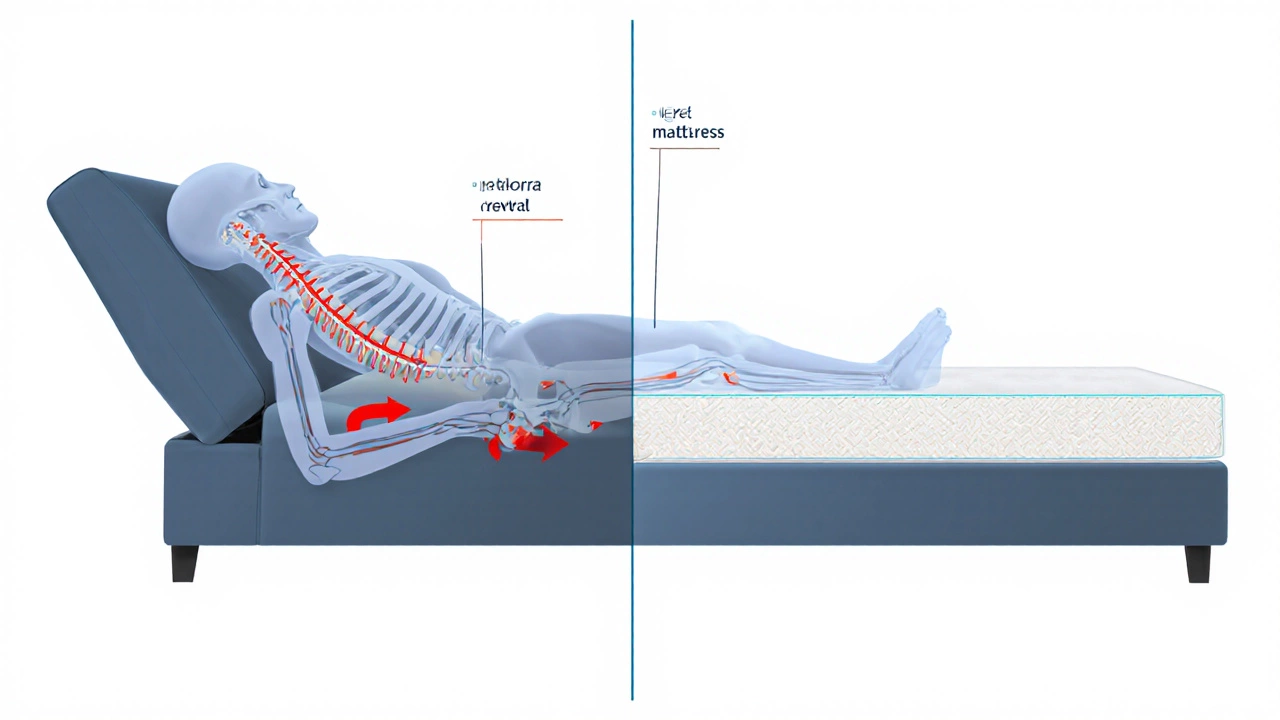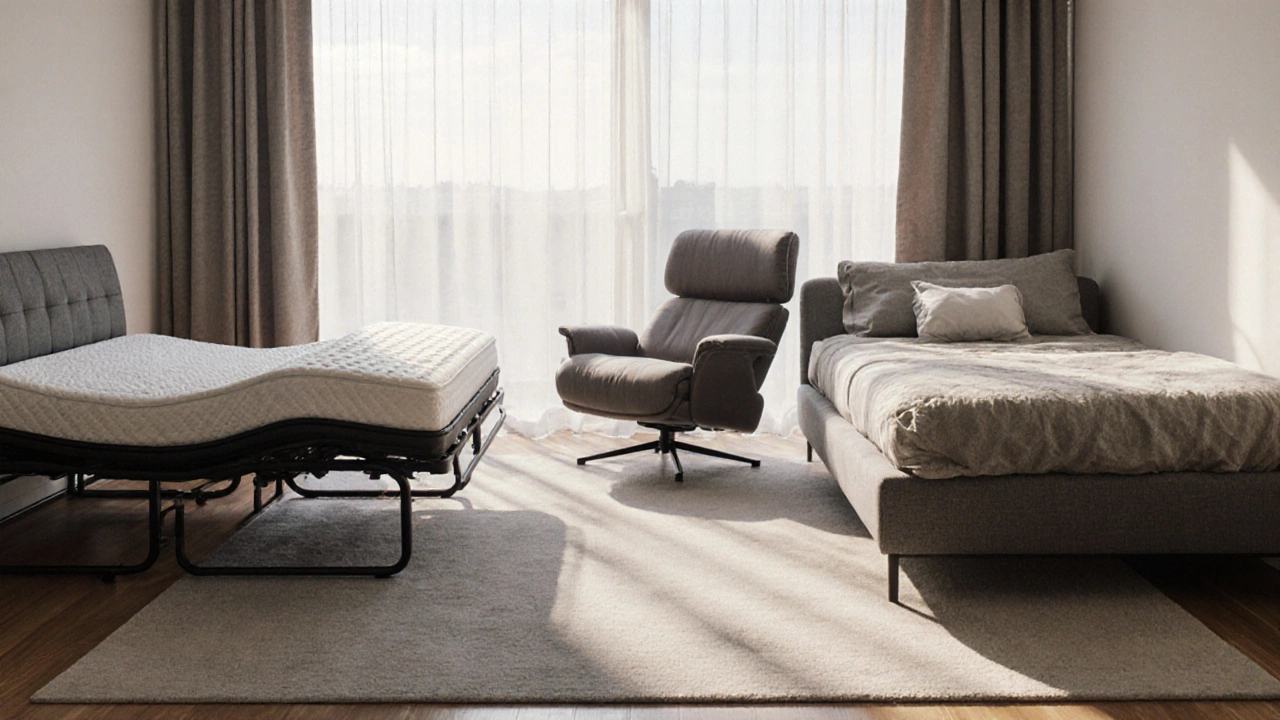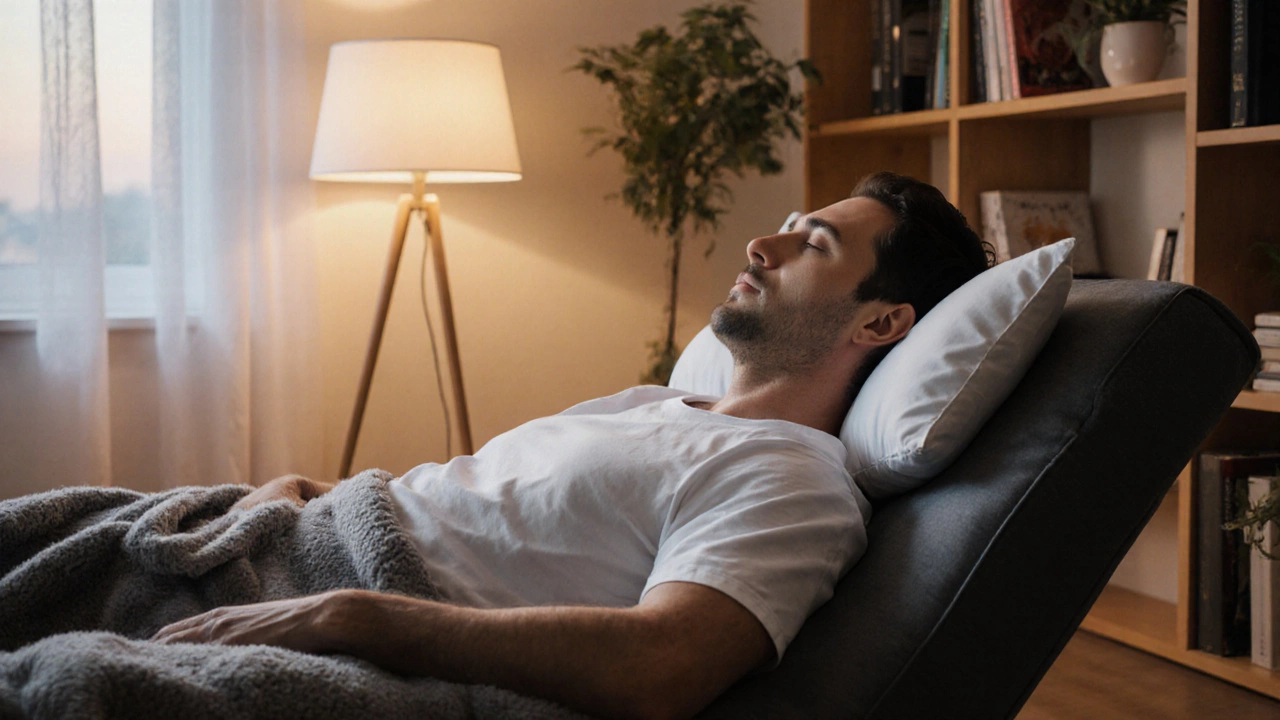Recliner Sleep Safety Checker
Your Sleep Safety Assessment
Key Takeaways
- Occasional naps in a recliner are generally fine, but nightly use can strain the spine and limit deep‑sleep cycles.
- Proper recline angle (around 100‑110°) and supportive pillows reduce pressure on hips and shoulders.
- People with chronic back problems, circulation issues, or severe arthritis should avoid making a recliner their primary bed.
- Consider a mattress topper or a specialized recliner‑sleep system if you must sleep there regularly.
- Watch for signs like morning stiffness, numbness, or worsening sleep quality - those indicate you need a better sleeping surface.
What a Recliner Chair Actually Is
When you settle into a recliner chair a swivel or stationary chair that tilts backward and often includes an extendable footrest, designed for relaxed seating, you’re using a piece of furniture engineered for short‑term comfort, not long‑term sleep.
How sleep the natural, cyclic state of rest where the brain and body repair, consolidate memories, and regulate hormones works in a recliner
During normal sleep, the body goes through light (N1, N2) and deep (N3) stages, followed by REM. A flat, supportive surface lets the spine stay neutral, which encourages uninterrupted cycles. A recliner tilts the torso forward, cuts down on the space needed for the legs, and creates a curved shape that can interfere with spinal alignment.

Impact on Your Body: The Science Behind Recliner Sleep
Spinal alignment is the cornerstone of a good night’s rest. In a properly aligned bed, the natural curves of the cervical, thoracic, and lumbar spine are supported. In a recliner, the hips are often higher than the shoulders, creating a forward bend that compresses intervertebral discs.
Research from the Australian Institute of Health (2023) found that sleeping at an angle steeper than 120° increases lumbar disc pressure by up to 15% compared with a flat mattress. Over time, that extra pressure can lead to chronic lower‑back pain.
Back pain discomfort or ache in the spinal region caused by muscular strain, disc degeneration, or poor posture is the most common complaint among nightly recliner sleepers. The uneven pressure often triggers muscle fatigue, especially in the erector spinae and gluteal muscles.
Blood circulation the movement of blood through the heart, arteries, veins, and capillaries delivering oxygen and nutrients can also suffer. When the legs are tucked under the chair, the femoral vein may be partially compressed, leading to temporary tingling or “pins‑and‑needles” sensations.
Another factor is pressure points areas of the body where bone is close to skin, making them prone to compression under hard surfaces. A recliner’s seat cushion is often firmer than a mattress and may not distribute weight evenly, causing numbness in the hips, tailbone, or shoulders.
Pros and Cons of Sleeping in a Recliner
| Feature | Recliner Chair | Traditional Bed | Sofa Bed |
|---|---|---|---|
| Support for spine | Moderate - depends on angle and cushion quality | High - designed for neutral alignment | Variable - often softer, less ergonomic |
| Space efficiency | Excellent - fits in a living‑room | Poor - occupies dedicated bedroom area | Good - dual purpose furniture |
| Cost | Low‑to‑mid (AU$300‑800) | Mid‑to‑high (AU$800‑2000) | Mid (AU$500‑1500) |
| Impact on sleep quality | May reduce deep‑sleep phases if used nightly | Optimal for full REM & deep cycles | Improved over recliner but still less than bed |
| Risk of back/neck pain | Higher if angle >120° or no lumbar support | Low with proper mattress | Medium - depends on mattress quality |
Who Might Actually Benefit from Recliner Sleep?
While the general recommendation is to keep a recliner for sitting or short naps, certain groups find it useful:
- People with limited mobility - a recliner can be easier to get in and out of than a low‑lying bed.
- Those who need to elevate legs - for edema or varicose vein relief, a reclined position reduces swelling.
- Travelers or renters - if space is at a premium, a recliner offers a compact sleeping solution without buying a full bed.
Even in these cases, experts suggest limiting nightly use to no more than 4-5 hours and supplementing with a proper mattress when possible.

Tips for Making Recliner Sleep Safer and More Comfortable
- Choose the right angle: Aim for a recline of 100‑110°. Anything steeper pushes the hips too high and stresses the lower back.
- Support the lower back: Add a lumbar pillow or a rolled‑up towel behind the small of the spine.
- Pad pressure points: A thin memory‑foam mattress topper (2‑3cm) spreads weight and reduces numbness.
- Elevate the legs wisely: If you need leg elevation, place a small footrest beneath the footrest to keep the knees at a 90° angle.
- Mind the bedding: Use breathable sheets and a light blanket; overheating can disturb REM sleep.
- Rotate positions: If you must stay in the recliner all night, shift your torso slightly every hour to avoid static pressure.
- Keep a regular sleep schedule: Consistency helps the body compensate for the less‑ideal surface.
These adjustments can lower the risk of muscle strain overstretching or over‑contracting of muscle fibers causing discomfort and improve overall sleep efficiency.
Alternatives to Consider
If you find yourself relying on a recliner nightly, explore these options before committing long‑term:
- Sofa bed with a high‑density foam mattress - offers a flat surface without sacrificing living‑room space.
- Adjustable platform bed - lets you raise the head or foot end, mimicking the recline without compromising spinal alignment.
- Floor futon - a thin, portable mattress that can be rolled up during the day.
Each alternative addresses the core issue: providing a neutral, supportive surface while preserving space.
Red Flags: When to Stop Sleeping in a Recliner
Pay attention to the following signs. If they appear, it’s time to switch to a proper bed:
- Persistent morning back or neck stiffness that lasts more than 30 minutes.
- Numbness or tingling in the legs, feet, or arms that doesn’t go away after a short walk.
- Worsening sleep quality - you’re waking up multiple times or feeling unrefreshed.
- Development of chronic conditions like sciatica, herniated discs, or worsening arthritis.
Consult a physiotherapist or sleep specialist if any of these symptoms linger.
Frequently Asked Questions
Can a recliner replace a bed for a healthy adult?
For short naps it’s fine, but long‑term use can disrupt spinal alignment, reduce deep‑sleep phases, and increase the risk of back pain. Most health professionals recommend a flat, supportive mattress for nightly sleep.
What recline angle is safest for sleeping?
Aim for 100‑110 degrees. Angles steeper than 120° push the hips higher than the shoulders, creating extra lumbar pressure.
Do I need special pillows when sleeping in a recliner?
A lumbar pillow or rolled‑up towel behind the lower back helps keep the spine neutral. A neck pillow that supports the head without tilting it too far forward is also useful.
Is it safe for seniors with arthritis to sleep in a recliner?
For seniors who have trouble getting in and out of a bed, a recliner can be a temporary solution, but it should not become the primary sleep surface. Regular check‑ins with a physiotherapist are advisable.
How can I tell if my recliner is causing sleep problems?
Track morning stiffness, numbness, and overall sleep quality. A sleep journal or a simple rating (1‑10) of how refreshed you feel can reveal patterns linked to recliner use.
Bottom line: sleeping in a recliner occasionally is okay, but making it a nightly habit can compromise spinal health, circulation, and sleep quality. Adjust the angle, add support, and stay alert to warning signs. If problems arise, switch to a proper mattress or explore space‑saving alternatives.

